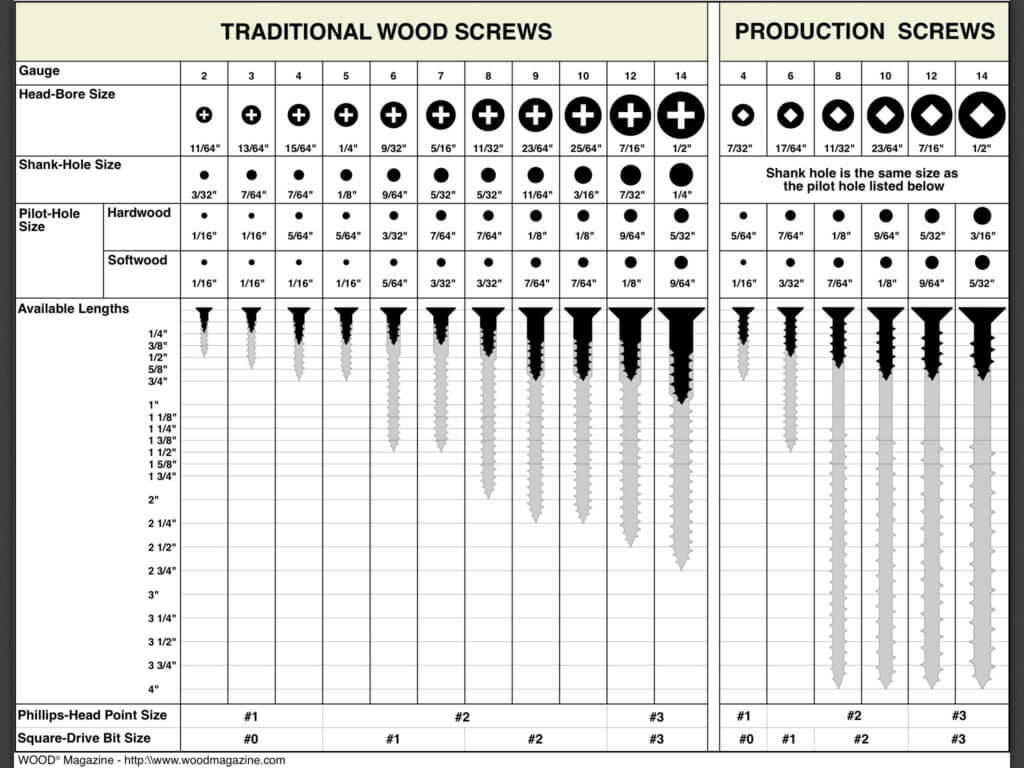You CAN build your own dream partscaster guitar, save some money in the process, and skip all the bonehead mistakes we made along the way. Here’s how.
STEP ONE: DOWNLOAD OUR PARTSCASTER CHECKLIST AND BUDGET SPREADSHEET
If we had all the time in the world, we’d spend most of it drooling over custom-built guitars on the internet. It’s like cute cat videos for musicians. Alas, time and money are typically an object for most, which is why the custom guitar route is oftentimes out of reach for most musicians. Fear not! You CAN craft a unique, one-of-a-kind instrument to your exacting specs, and you can build it yourself for a lot less money than high-end luthiers will charge for their time, skill and expertise.
Now, to be clear here, we’re talking about partscasters, specifically guitars put together from aftermarket parts, typically meant to be assembled together in an F-style guitar or bass (think Strats, Teles, Jazzmasters, P and J-Basses, etc., although you can get bodies in a variety of standard and more exotic shapes). Bolt-on assembly is the name of the game here, and with the wide array of body and neck suppliers as well as a myriad of hardware, pickup and electronics options at your disposal through mail-order catalogs and the internet, building your dream guitar has never been easier or more affordable and accessible. We did it! [see figure 1]
[insert_ad]
RELATED: Warmoth explains 3 commons mistakes to avoid on your next Partscaster build.
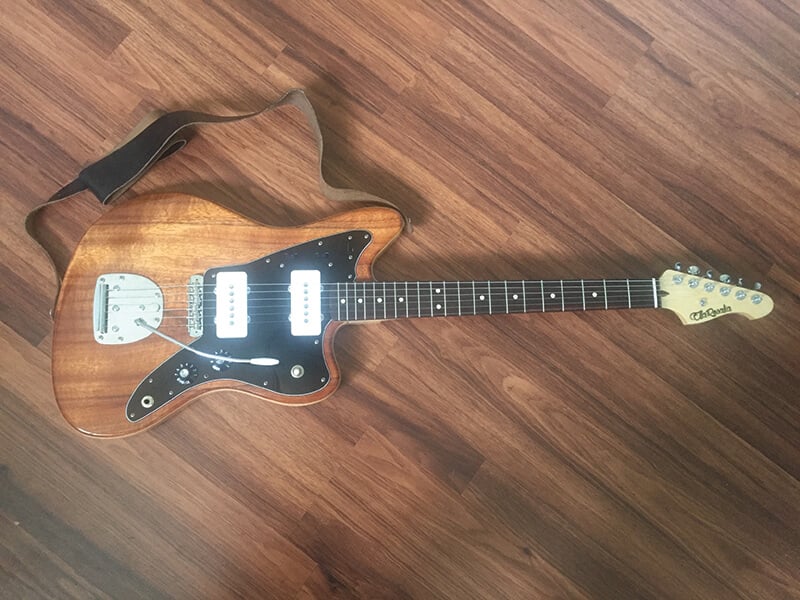
FIGURE 1 – Final Warmoth Jazzmaster Assembly
For our build, we wanted to go through the entire process, not so much to provide a step-by-step guide for how to assemble your partscaster, but rather to show you some of the things that they never tell you about assembling your guitar on those forums you might frequent, and also some of the mistakes we made so you can avoid them 1) to save yourself the time and hassle of going back to fix them like we did and 2) so you don’t have to waste money paying someone else to put your instrument together for you. You can do it, trust us. If we can do it (and we can barely swing a hammer), ANYONE CAN ASSEMBLE A PARTSCASTER.
For starters, we recommend you assemble your partscaster in the following order: neck, body, electronics, final assembly. Trust us, after doing a build of our own, this order makes the most sense. And don’t forget to pop on over to the Performer YouTube channel for some helpful video tips that explain some of the points below in a more visual way. Now, on to the build process!
1. CHOOSE YOUR PARTS
Time to shop: The first part of the process is arguably the most fun. Here’s where you’re gonna spec out all of your parts, down to the nth degree, exactly how you want them. We chose to go with Warmoth for the majority of our build, including the body (a Jazzmaster, since offsets are proving pretty popular nowadays), [see figure 2] the neck (one of their cool Warhead designs) [see figure 3] and most of our hardware. We love Warmoth, we recommend Warmoth and we’d 100% go with Warmoth again. They’re simply good people who make incredible replacement bodies and necks here in the USA at a fair price.
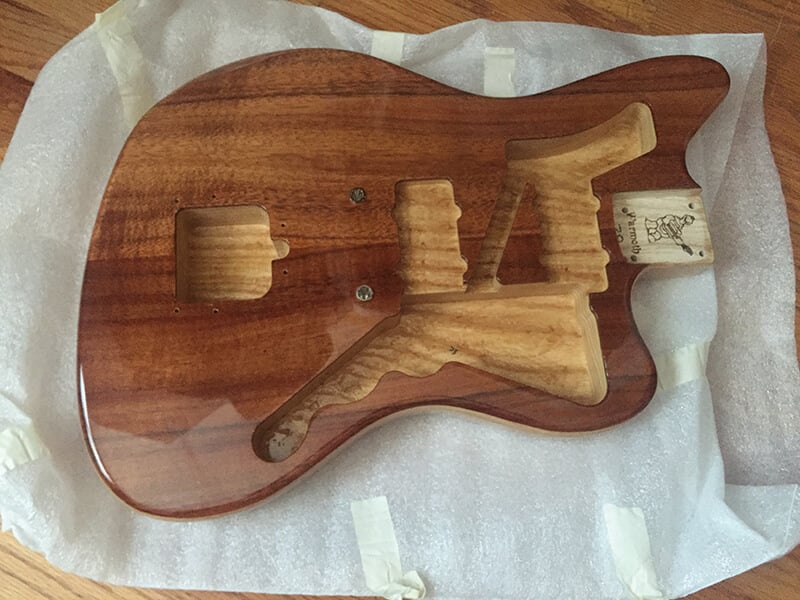
Figure 2 -Warmoth Jazzmaster body
Their folks are excellent to work with and will provide guidance every step of the way during your project. They also have an incredibly robust online shopping mechanism that will guide you step-by-step through your ordering process, allowing you to customize each part for your tastes (neck radius, fret size, types of woods, body routing, pickguard configurations, etc.). We managed to snag a gorgeous koa top on a lightweight ash body. If weight is a concern for you, they have a showcase of pre-built bodies that list the weight – an awesome touch!
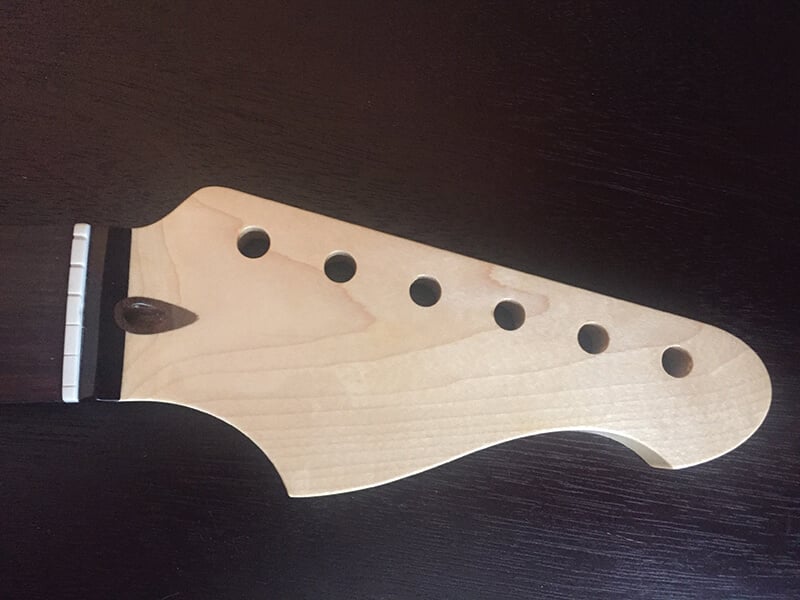
Figure 3 – blank headstock
What we learned: One thing we recommend is that no matter what type of guitar you want to build for yourself, whether it’s a Strat or Tele style, Jazz Bass or something else entirely, try to match it up against another production model that is at least somewhat similar so you don’t forget to order any parts. We forgot some small stuff like the felt pads that go in between the body wood and the strap buttons [see figure 4], and simple things like pickguard screws the first time around. Luckily, Warmoth’s custom ordering process remembers (and suggests) a lot of this stuff for you based upon the body and neck you’re ordering, but things like string trees are easy to neglect if you’ve never done this before.

Figure 4 – strap button
2. GATHER YOUR SUPPLIES AND TOOLS
Get organized: Label everything when it arrives, regardless of which retailer you order parts from (and let’s face it, you may end up getting different pieces from different suppliers, who may or may not be good at labeling what they send). Things like small screws can easily get confusing if you don’t label and take photos right away.
Create an inventory list in a spreadsheet program with all of your parts, the quantity and price for each so you can budget properly, and a running total of items ordered, items yet to be ordered, items arrived and your total running cost.
DOWNLOAD OUR PARTSCASTER CHECKLIST AND BUDGET SPREADSHEET TEMPLATE
Here’s what we learned: You’re going to need some tools to put this all together, obviously. We’ll assume you have the basics like a Phillips-head screwdriver, a drill and a small hammer. You’ll also need some more specific gear like a soldering iron, so we recommend a 40-watt iron and 60/40 rosin-core solder (you only need one spool for a project this size). A 40-watter will provide enough heat for small parts like potentiometers but won’t fry your electronics. A smaller wattage iron is basically useless for guitar work. You’ll also want to invest in three deep sockets: a half inch, a 10mm and a 7/16”. These will make tightening parts like tuning keys, output jacks and nuts on your electronics MUCH easier. You’ll also want to invest in a drill bit kit that includes at least a 1/16” bit and a 5/64” bit, the two most common bits we used for drilling pilot holes.
Pro (well, amateur) tip: A sturdy ironing board makes a great makeshift work station if you don’t have a decent garage!
3. START WITH THE NECK
Working on small parts one at a time is the way to go; we learned that the easy way. You may be tempted to start bolting your neck to your body right away, but trust us, one slip of the drill and you can easily ruin a bunch of your dream parts in one fell swoop. Order a neck with the shaft wood and fingerboard woods of your choice, the inlays and binding of your choosing already installed, frets (of your choosing) and a nut (also of your choosing) already installed as well. Unless you want to deal with that nonsense, there’s no need for the extra work (unless of course you like it). We’re assuming you want a kick-ass custom guitar, not an apprenticeship as a luthier. And luckily, Warmoth’s custom neck builder allowed us to do all of this in about 2 minutes.
Your decal: First up, apply your logo or decal (duh). We personally think adding a Fender logo to a guitar Fender didn’t build is not only lame, but dishonest and really getting into counterfeit territory, even if it’s for your own personal use. Instead, we recommend you design your own logo [see figure 5], and either print out a vector version using waterslide decal paper at home, available on Amazon or at most hobby shops, or you can design one online and have it shipped to you. We used customluthiersupply.com to design and print our decal and it arrived with instructions in a few days. Easy.
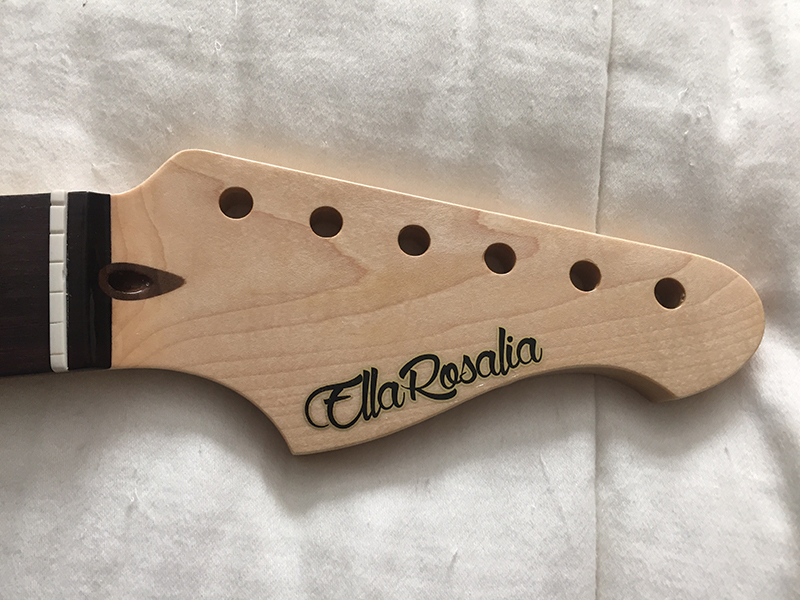
Figure 5 – waterslide decal applied
Here’s what we learned: We did the decal first for two reasons. First, it made the project feel real, to see that logo staring back at us, like it was a real guitar all of the sudden and not some generic blank. And second, because you’re going to need to seal your waterslide decal with a clear coat, and then either fine sand or wet sand and buff for a glossy look (if so desired). So, adding your tuners and string tree now is a waste of time, since you’ll just need to remove them right away to shoot some clear and sand [see figure 6].
We recommend a polyurethane-based clear gloss (or satin, if you prefer). It sprays easily (do it in a well-ventilated area or outdoors), and it hardens fairly quickly, too. Allow your waterslide decal a full 24-hours to dry before spraying your clear coat, then apply 2-3 even coats in 2-hour intervals. Allow THAT to dry for another 24 hours then use a fine 000 or 0000 grade steel wool or wet sanding solution to smooth out your clear coat and headstock surface to taste. This is just how we did it; we’re not going to get into a nitro vs. poly debate.
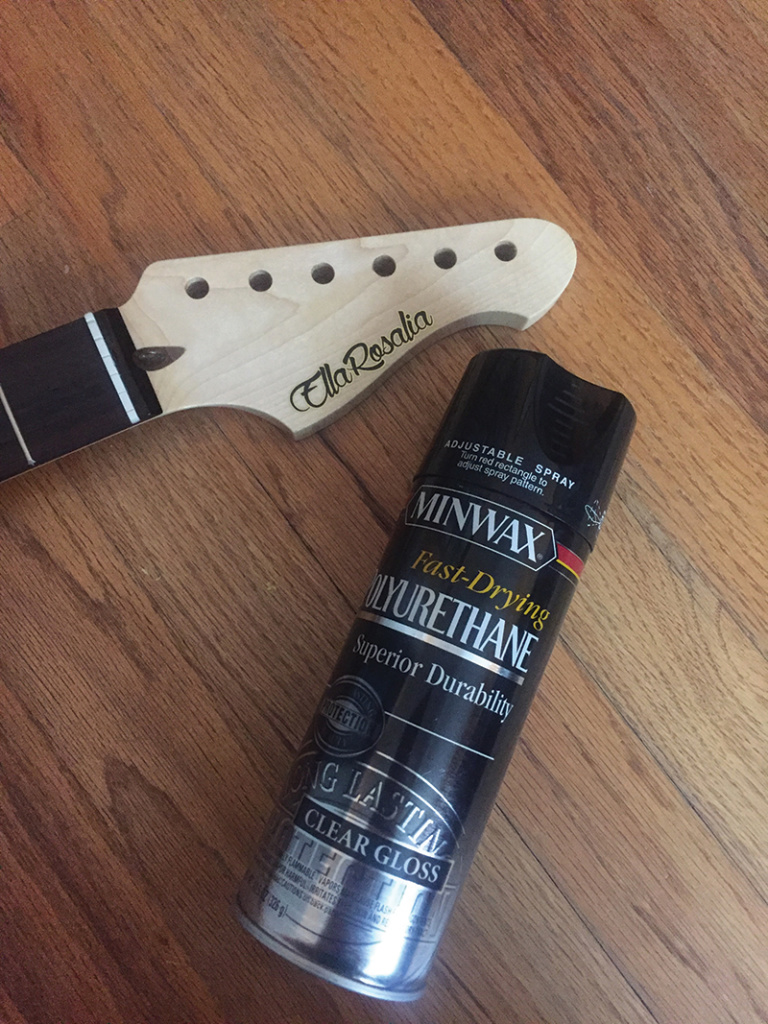
Figure 6 – clear coat for the headstock
A word on pilot holes: Now that your decal is sealed and looking good, insert your tuners to mock up their final placement, use a fine-tipped Sharpie to mark a dot where pilot holes should go, and then remove the tuners to drill your holes. [see figure 7] We recommend using the reverse setting on your drill with the proper sized pilot drill bit in (we have a chart below for different wood screw sizes), and SLOWLY make a small divot in reverse mode on your Sharpie mark. Then put the drill in forward, and go straight down the depth of the hole you desire. We recommend using a bit of masking tape to mark a “cut-off” point directly on your bit so you know where to stop and don’t drill too deep.
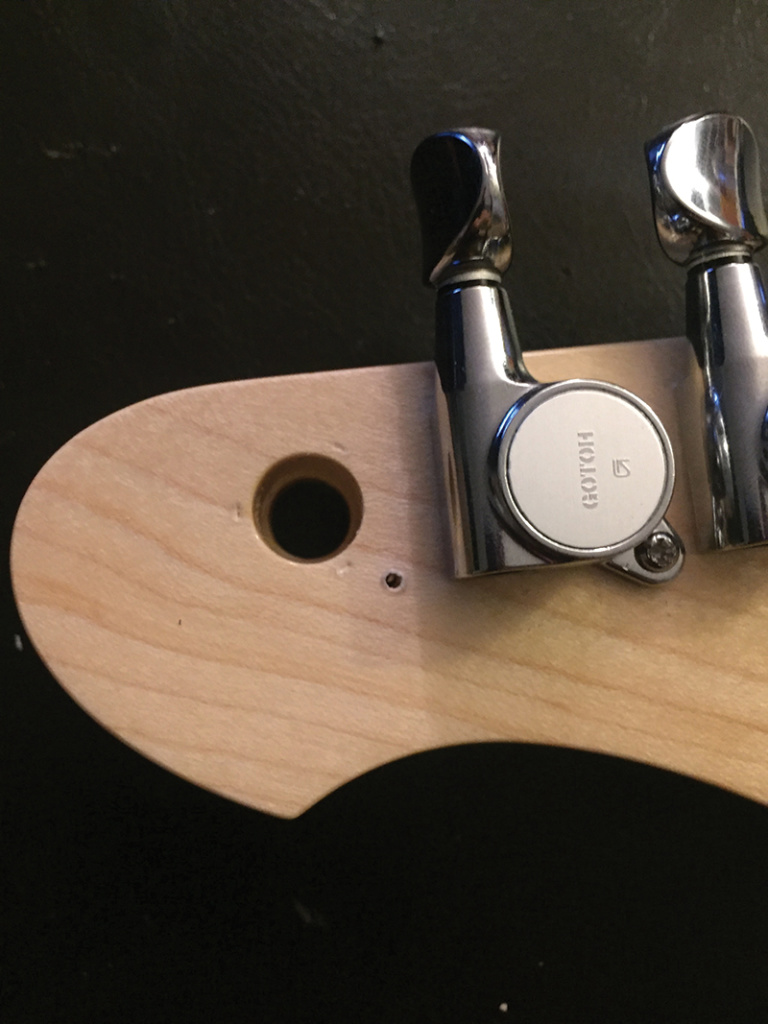
Figure 7 – pilot holes for the tuners
What they don’t tell you about tuners: Here’s the deal – you can use almost any tuners and be fine with tuning stability. Most tuning issues occur as a result of binding at the nut or something moving at the bridge. So, when ordering a neck, go with a reputable builder (cough Warmoth cough) and that way you’ll ensure your nut slot is cut properly and uses the material of your choosing (Warmoth offers a TUSQ XL option that is great, you could also go with bone or a synthetic, which is great, too). SAVE MONEY here by buying a good set of tuners, sure, but not necessarily the most top of the line if you have it in your head that they’ll help you stay in tune better. That’s not the case. A proper setup will keep you in tune. Almost any stock tuner will work just fine.
Sting trees: Mark off your string tree pilot hole in the same fashion. A string tree is common on most F-style guitars to compensate for a weak break angle over the nut on the high E and B strings. Usually it’s placed between those strings, at around the 4th or 5th tuner position. We eyeballed ours (I know, right!) because really all you’re looking for is an increase in downward pressure as those strings pass on to the tuners. If your neck is angled downward or the strings are splayed (like Gibson-style necks), then forget the string tree altogether; you don’t need it. [see figure 8]
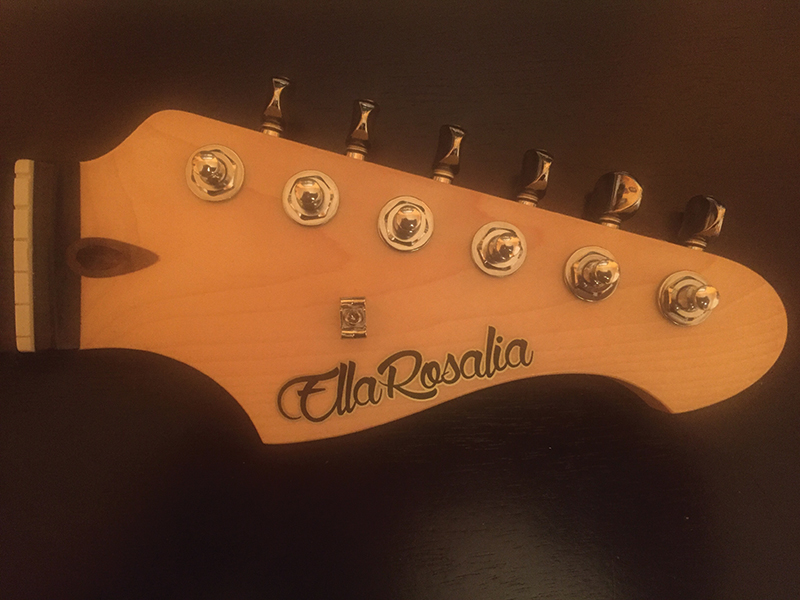
Figure 8 – final headstock
4. WORK ON THE BODY
Get the neck out of the way first, put it aside, and move on to the body. First, we recommend drilling pilot holes (again, consult the chart for the right drill bit to use) for the strap buttons, pickguard, pickup mounting, tailpiece and bridge. [see Figure 9]
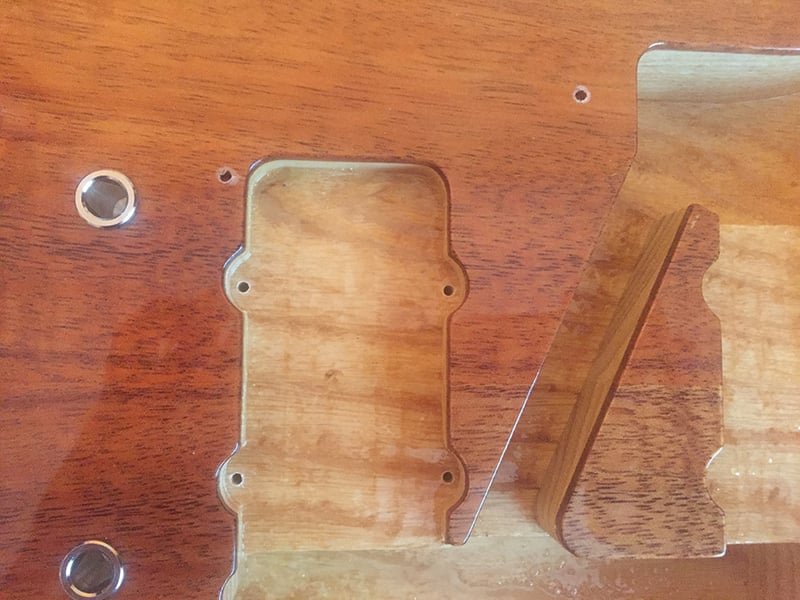
Figure 9 – body pilot holes
A word on bridge thimbles: Our Jazzmaster build uses bridge thimbles, which the bridge itself rests in. Strats and Teles don’t use these, but here’s a word of advice anyway. Bridge thimbles are supposed to be super snug in their slots. So you’re gonna try easing them in by hand, and that ain’t gonna work. Instead, position them directly over their post holes, take a small rubber mallet, or double up a hand towel over the end of a small hammer, and GENTLY start tapping (not pounding) them in place. A few soft, solid whacks’ll get them in there nice and tight, and you won’t feel like an idiot calling customer support telling them they didn’t fit. Allow us to be that idiot for you!
At this point, with pilot holes drilled and strap buttons in place, your work on the body is pretty much done. Wait until your electronics are in before popping on your bridge and tailpiece.
5. COMPLETE THE ELECTRONICS
It’s time to cheat: OK, no one else will say it, so we will. Soldering sucks. It’s a pain in the ass, and anyone who says otherwise or claims to enjoy it is a dirty rotten liar. Which is why we totally cheated, and ordered a wiring harness off the internet. [see figure 10] Yes, you too can be a cheat, and we totally encourage it! Ordering a wiring harness is an easy (and surprisingly affordable) way to complete most of your soldering work, while at the same time not having to deal with confusing wiring charts and knowing which pots, switches and knobs to order.
Now, if you WANT to do all your own soldering or pot-ordering (no, we don’t mean that), don’t let us intimidate you. A soldering iron’s only job (we’re simplifying here) is to heat up metal. That’s it. Don’t let it scare you. You heat up metal, let some solder flow over what you’re mating, and give it a second to join before removing the heat. Bingo bongo. There are tons of videos out there to help, if you so desire, although we still lean on the side of cheating.
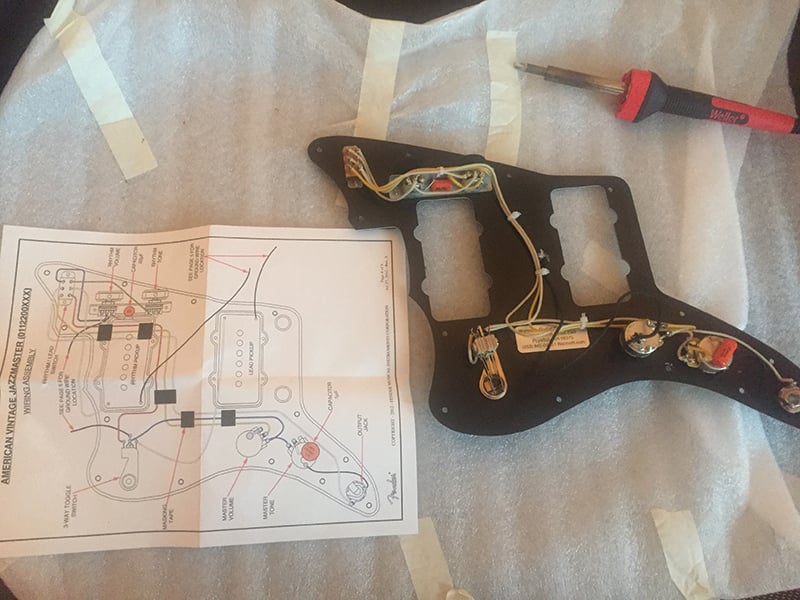
Figure 10 – wiring harness
OK, you can’t totally cheat: So will you need to do any soldering? If you cheated like us, then unfortunately yes. But not much. We got a great set of pickups courtesy of the amazing Jason Lollar [see figure 11], and we needed to only consult out wiring chart (which you can totally grab for free from the Seymour Duncan website) to figure out where our leads and ground wires were supposed to go. We hooked up the bridge pickup lead to the right spot (making a solid mechanical connection before flowing the solder), and wired the ground to the back of the pot. We soldered the bridge pickup’s hot lead to the right lug, too, and grounded that to the back of a pot, and the simply added a ground wire from the back of a pot through the body to the underside of our tailpiece. See, not too bad, right?
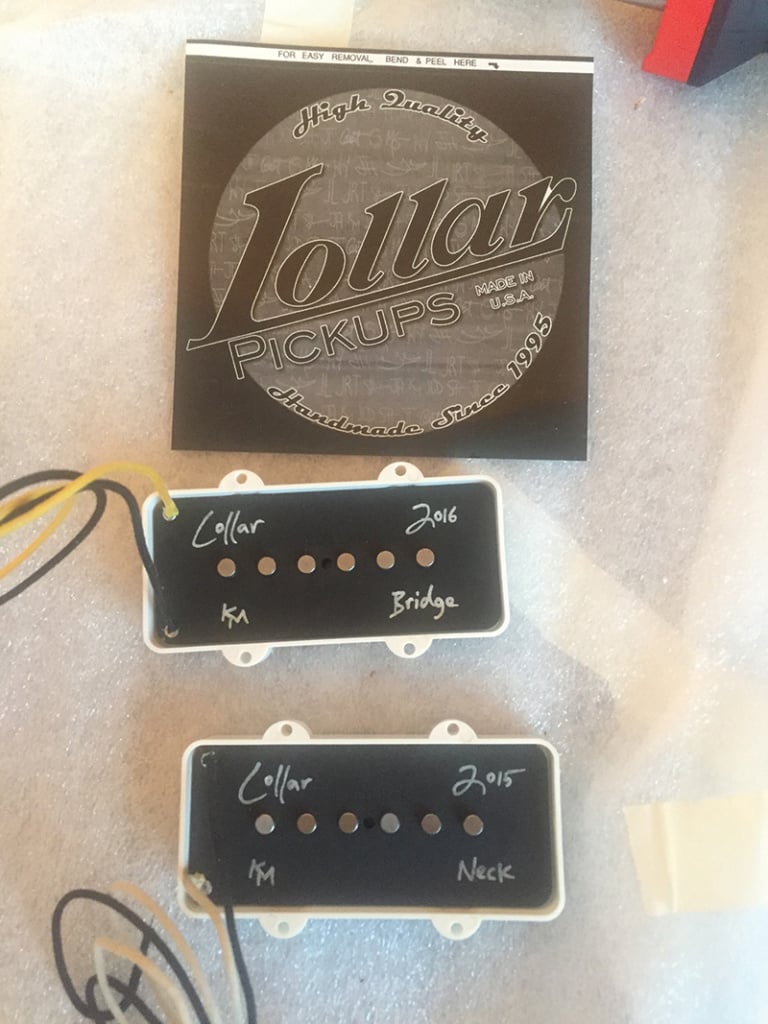
Figure 11 – Lollar pickups
Don’t waste time on things you don’t like doing: No one is going to take your street cred away if you don’t laboriously solder every point by hand. We don’t like soldering, so we took the easy route. There’s no right or wrong way to assemble YOUR guitar. Don’t let any internet forum jerk (even if it’s us) convince you otherwise. You don’t need to impress anybody. Seriously.
Shielding counts: Single coil guitars (and even humbucker equipped guitars for that matter) can be noisy and subject to interference sometimes. Proper grounding and shielding should help alleviate some of that. Copper shielding tape is easy to apply, and widely available online for cheap. It’s a step a lot of first timers overlook, and it’ll be something you’ll be glad you took care of now. It won’t completely silence single-coil guitars, but it’s a worthwhile step to take.
6. FINAL ASSEMBLY, YAY!
What we learned about neck pockets: For those of you doing Tele and Strat-style builds, know that their respective necks and neck pockets are not always compatible. So check the specs first before you get it in your head to do something awesome like throw a replacement Tele neck on your Strat build.
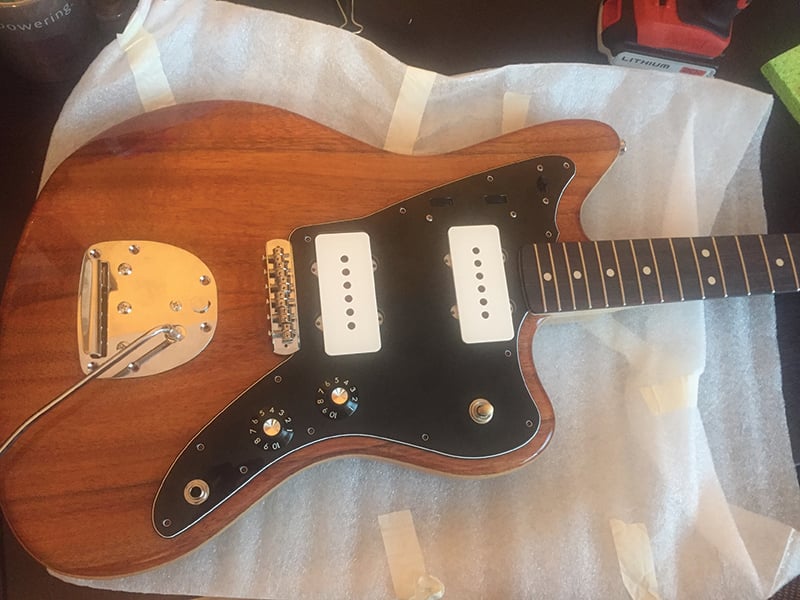
final body and electronics mocked up
What we learned from joining the neck and body: We’ll let you in on a tip NO ONE EVER TELLS YOU: once your electronics, pickups, neck and body are all in their final stages of completion, when it comes time to place the neck in its pocket, go TOP DOWN. Do not insert the neck from the side.
Position it over its pocket and GENTLY start easing it downward, rocking it ever-so-slightly to lower it into place. Trust us, you don’t want to ram it in from the side. You can inadvertently chip some of the finish or worse, misshape the pocket so that your neck won’t fit snugly when assembled. Get a good, solid fit first, and then bolt it on. [see figure 12]
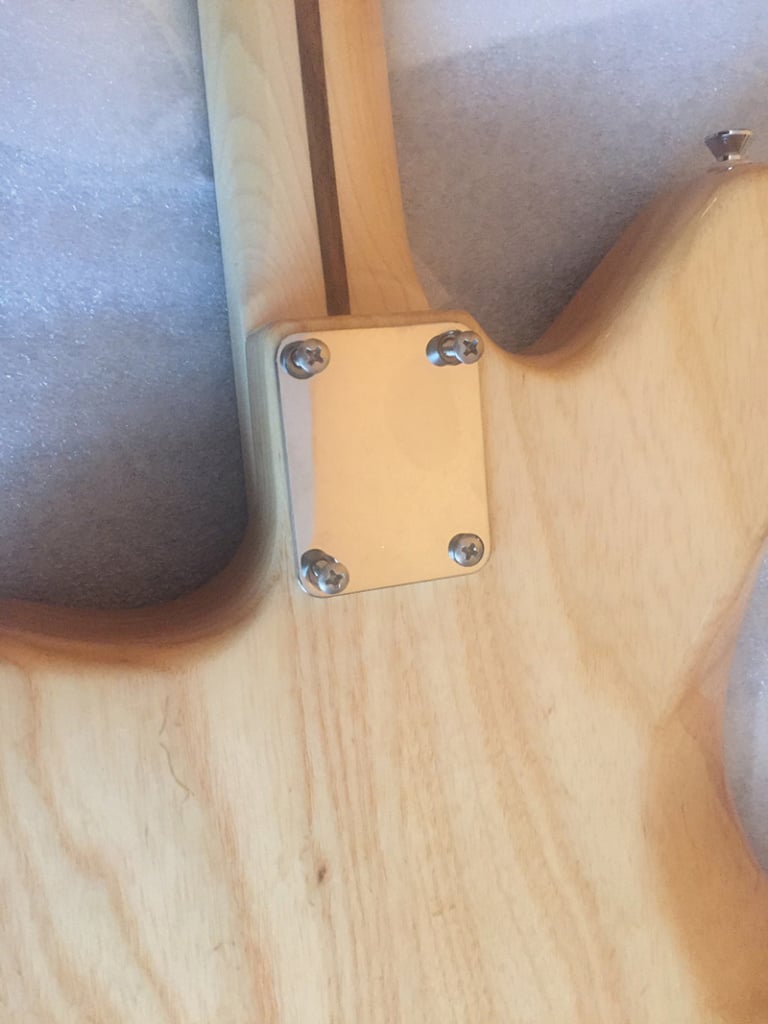
Figure 12 – bolting the neck plate
To shim or not to shim? Shimming a neck, or adding a thin veneer of wood, plastic or other material in the neck pocket to achieve the desired neck angle IS NOT A SIGN THAT YOU FAILED! Heck, tons of guitars come off the line with neck shims from the factory. It’s simply a method of getting the proper angle of the neck to the body, so that when adjusted properly, the strings travel at the right angle from the bridge to the nut. On Jazzmasters in particular, that break angle is often hella weak, and even the best setup might require a shim to get the strings low enough on the neck to make the dang thing playable. Our Warmoth neck was perfectly straight, and the truss rod was super easy to adjust, so once our shim was in, we were golden. We used a 1 degree full pocket shim from StewMac; they’re inexpensive and covering the entire neck pocket will reduce the chances of any warping or ski-jump neck scenarios a few years down the line.
7. A NOTE ON FINISHING
Unless you have your own spray booth or plan on doing a simple stain or Tru-Oil rubbed finish, screw it. It’s hazardous for starters, and you’re likely not gonna be skilled enough on your first attempt to do a showroom worthy paint job. Factor in all that time sanding and buffing, too, and you can see how our lazy butts decided to skip this one altogether. Let the pros handle it; we ordered our Warmoth body with a simple clear coat and for the cost of their in-house paint job and the ridiculously high quality they deliver, it’s just not worth your time. Normally, we’re all gung-ho on the DIY front, but this is one area we recommend skipping your first time out, unless you’ve had tons of practice finishing wood before. And again, let’s not start a nitro vs. poly debate.
8. FINAL SETUP
It’s OK to fail: We decided to bring our final, assembled dream guitar in to the shop for a pro setup. While you can of course set up your own axe, and we totally recommend doing so from here on out, at least for its initial inspection, it’s always good to get a second pair of eyes on your project. We discovered a ground wire issue that was causing some noise. Something we didn’t catch, but a trained eye saw right away. You’re not a failure if you’re partscaster build didn’t come out perfectly the instant you finished drilling the final screw in place. Allow the completed guitar to sit for a day or two and let the parts become one, adjust to your climate, and let the neck and body become accustomed to having string tension on them. THEN do your set up. It’s OK to bring it to a pro; it’s not a sign you’re a total loser. Because if you’re a loser, then we’re losers, and honestly we can’t deal with that right now…
9. ADDITIONAL PARTSCASTER RESOURCES
Need more info? Check out our YouTube channel for some video tutorials to help with your build or simply email your questions to [email protected]. Otherwise, bookmark these links below. And most of all, have fun! Skip the crap you don’t like and focus on the things that are actually enjoyable. This shouldn’t be a chore — it should be a blast!
1. Warmoth Custom Guitar Parts – www.warmoth.com
Excellent source for replacement bodies, necks, hardware and electronics. We give them a lot of love for a reason. With over 30 years’ experience, they will deliver exactly what your project needs, and they’re amazing to deal with.
2. Stewart-MacDonald – www.stewmac.com
StewMac has everything under the sun you need to complete a partscaster assembly, and advanced tools and accessories for luthiers to build stringed instruments from scratch.
3. ReRanch Guitar Refinishing – www.reranch.com
If you plan on painting and applying a finish to your instrument yourself, ReRanch has all the supplies and tips you’ll need to do it right. Good luck.
4. AllParts – www.allparts.com
Another reputable replacement body and neck supplier, as well as offering a slew of electronics, knobs, hardware, etc.
5. Guitarfetish – www.guitarfetish.com
For the partscaster build on a micro budget, GFS has pickups, bodies, necks and hardware at ultra-low prices. Most pieces come from the Far East and quality varies, but if the name of the game is saving money, it’s a starting point.
Fantastic message board for all things offset. If you’re planning a first-time Jazzmaster, Jaguar or Mustang build, these fine guys and gals will be your lifelines.
7. The Gear Page – www.thegearpage.net
Another well-trafficked forum that has tons of answers to even the most obscure questions about guitars and the build process.
8. Lollar Pickups – http://www.lollarguitars.com/
Jason Lollar makes some of the best pickups money can buy, and his company offers pretty much everything under the sun as far as pickups go. We can’t recommend their gear enough. You can also read our interview with Jason Lollar to learn more about his process and some cool behind-the-scenes info.
We hoped you enjoyed our partscaster build, learned a few tips along the way, and decide to do your own. Let us know what you think in the comments below or drop a line on the Performer Magazine Facebook page or on Twitter @Performermag.

